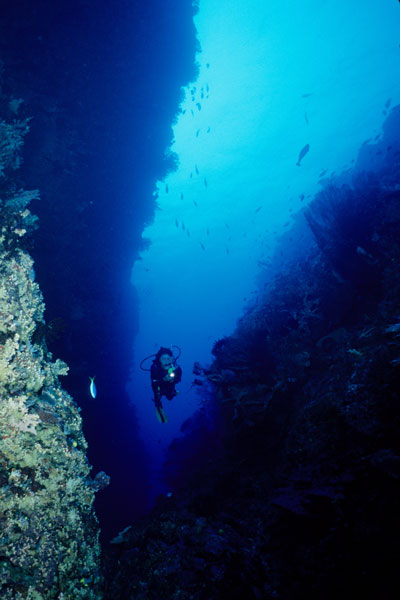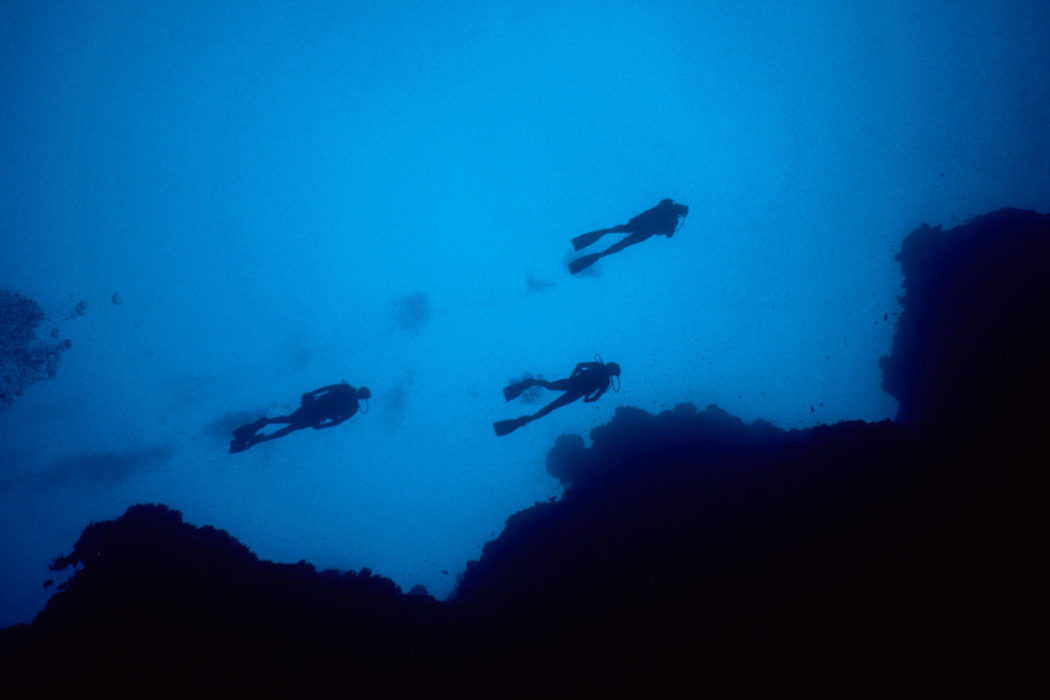When you are referred to as being off the wall, it doesn’t necessarily carry positive connotations. But to scuba divers who have descended over the sheer vertical facades that surround the world’s landmasses — from the largest continents to the tiniest islands — being off the wall is a sensation like no other. My first off-the-wall diving experience was one I’ll hold dear forever.
After a short boat ride to the site, we entered the water and snorkeled to the mooring line. Once ready, the dive guide signaled for the group to descend. We slowly drifted toward the bottom, using the mooring line as a reference.
Unable to see the wall as we descended, I tried to visualize what it would be like. More experienced divers had talked about the wall as if it were some sort of magical, mysterious domain. The anticipation triggered anxiety. As my fins contacted the powdery sand at the bottom of the mooring line, I checked my depth gauge. Fifty-two feet.
After exchanging the standard “OKs,” the guide motioned for us to follow. In single file we headed into a crevice of large coral formations grown together overhead. Part way in the crevice darkened to a tunnel. Shimmering streaks of sunlight filtered from cracks in the ceiling. Still anxious about my first time wall diving, I focused on the cobalt-blue oval that penetrated the darkness 20 feet (6 m) ahead.
The guide exited the yard-wide opening and swam to the side, leaving an unobstructed panorama of the clearest, deepest, bluest water one could imagine.
My heart skipped a beat. My eyes strained to adjust to the shafts of sunlight streaming from above and melting into the shadowy depths below. To the sides in either direction was a vertical facade — nearly straight up and straight down — adorned with brilliantly colored sponges of all shapes and sizes. Thirty feet (9 m) of coral towered above us like a fortress, separating the sand bottom that extends from shore and the open ocean that beckons beyond.
What lay below was even more mesmerizing — hundreds, even thousands, of feet of vertical wall, blanketed with coral and sponges. It was like leaning out the window of a skyscraper and peering at the side of the building stretching downward to an invisible street below. Beyond the wall was an endless expanse of shimmering blue.
My first inclination was to retreat, in fear of drifting into the depths. But a couple of short blasts of air into my buoyancy compensator (BC) provided reassuring neutral buoyancy. I hovered motionless, awestricken by the surroundings. Finally, I was diving the wall.
Then and there, wall diving became my favorite type of diving adventure, and it still is. Since that memorable moment off Seven Mile Beach in Grand Cayman I have dived walls all over the globe, from the Caribbean to Hawaii and Indonesia to Galapagos. Some walls are more intriguing than others, but I never have dived a wall that I haven’t enjoyed.

Many walls are convoluted with overhangs, crevices and swimthroughs. ©Laymon/Walden
No Two Walls Are The Same
After that first wall diving experience I went on to dive a different site along the wall every day of that weeklong vacation, and no two were the same. Sure, many had similar characteristics, but each wall has its own personality, features and residents.
Many of the wall diving sites along Grand Cayman’s Seven Mile Beach begin in 50 feet (15 m) of water. After descending the mooring line, divers navigate short coral tunnels or crevices before emerging on the face of the wall at around 80 feet (24 m). From there the guide leads you along the vertical facade to nearly 100 feet (30 m), around coral outcroppings and through tunneling crevices encrusted with brilliant sponges and vibrant coral, before beginning a slow exploratory ascent back to the top of the wall and the mooring line where you started.
The North Wall of Grand Cayman, that famed drop-off that skirts the island’s north shore, begins slightly deeper; the top of the wall at many sites is 60-70 feet (18-21 m). The contour is somewhat different as well. The swim from the sandy bottom at the mooring line to the point on the wall where you look down and see nothing but blue water is often reached through sandy-bottomed ravines. The face of the wall is more convoluted than the Westside wall.
The criteria that set walls apart are the depth at which the wall begins, its distance from shore and the sheerness and contour of the facade.
With a few exceptions, walls in the Caribbean begin at depths in the 40- to 60-foot (12- to 18-m) range, are within a couple miles of shore and display a variety of slopes and contours. One notable exception is the Great Wall off Little Cayman’s north coast; it begins in 15-20 feet (5-6 m) of water, is perfectly vertical — straight up and straight down — and is close to shore. Diving the Great Wall is like scaling the side of a skyscraper, except this skyscraper is covered with marine life.
Walls in the South Pacific generally begin shallower and closer to shore. In Indonesia and Papua New Guinea for example, it is not uncommon for the lip of the wall to be only a few feet (1-2 m) beneath the surface and within swimming distance from shore, with the bottom of the wall descending to hundreds or even thousands of feet.
The sheerness and contour of a wall varies from country to country and site to site. Like the Great Wall, some walls are perfectly sheer, with holes and crevices large enough for only tiny marine creatures to take up residence. Other walls are honeycombed with tunnels, crevices and swim-throughs, creating a maze of interconnected passageways, some too small to navigate, others forming large rooms in the face of the wall.
Walls are often stair-stepped with terraces every 100 feet (30 m) or so of depth. They range from moderately sloping to straight up and down. Every wall holds a new adventure and a new challenge.
Although the wall diving most people rave about is found in tropical waters, sheer vertical facades exist at inland dive sites throughout North America as well. Just about every former stone quarry that has been transformed into a dive destination contains at least one wall. Often the perimeter of the quarry is a vertical face that extends from a few yards (3-5 m) below the surface, all the way to the bottom. Visibility may not be as clear and the marine life as varied and colorful as that experienced when diving tropical walls, but quarry walls are a good place to learn and practice wall diving techniques.
Life On The Wall
One of the thrills of diving a wall is the marine life. The wall and the reef atop it serve as a barrier between deep, open ocean and the shallower, protected water on the shoreward side. Pelagics often emerge from the depths to feed on the smaller fishes that inhabit shallower water.
In most parts of the world it is not uncommon to sight sharks, manta rays, eagle rays, large tuna, ocean triggerfish and even an occasional whale shark cruising the wall in search of a meal. You never know what is going to appear out of the deep and distant blue.
The wall itself provides domain for innumerable smaller creatures. The honeycomb of tiny cracks, crevices and holes that dot a wall provide hiding places and living quarters for tunicates, mollusks, crinoids, crabs and other invertebrates of all sizes and shapes, plus, of course, sponges and coral. In the South Pacific, lionfish, frogfish and leaffish commonly inhabit ledges and small crevices along the wall.
Many walls are so heavily blanketed with marine life that you can spend an entire dive observing the tiny creatures that inhabit just a few square yards (3-5 sq m) of the wall. However, don’t become so engrossed that you forget to glance over your shoulder to see what might be passing by in the blue water behind you.

With no bottom to use as reference, wall divers must possess astute buoyancy skills. ©Laymon/Walden
Special Skills for Wall Diving
Diving the wall is not for the poorly trained or rusty diver. It does not require unusual physical conditioning or special skill development, but good diving fitness and mastery of basic scuba skills are a must. Excellent buoyancy control, astute depth, air supply and bottom time monitoring are important. Divers must understand the physiological challenges, namely nitrogen narcosis and an increased risk of decompression sickness, associated with deeper diving. A thorough understanding of dive tables and/or computer savvy and the ability to perform controlled, slow ascents and safety stops are all important. Many divers enroll in a wall diving specialty course to ensure that they are adequately prepared.
Since the majority of walls are effectively bottomless and the water often gin-clear, it is easy for a diver to descend beyond the planned maximum depth, even beyond the sport-diving limit: 130 feet (40 m). That is one obvious reason why buoyancy control is a critical skill for wall diving.
Because a diver becomes more negatively buoyant as he descends, it is important that he add air to his BC as he goes deeper on the wall. This slows the rate of descent and makes it easier to establish neutral buoyancy upon reaching the desired diving depth.
To avoid exceeding the planned maximum depth, wall divers begin leveling off — halting the descent — at least 10 feet (3 m) before reaching the planned maximum depth. This is accomplished by adding short blasts of air to the BC. Keep in mind, however, that it takes a few seconds to realize the effects of adding air. It is easy to add too much air too quickly, so be prepared to vent air if you begin floating toward the surface. Once neutrally buoyant at diving depth, wall divers switch from their vertical descent position to horizontal trim and explore the wall laterally.
A mild to swift current is common along walls, so they are often explored as drift dives — you simply float with the current and the boat picks you up when and where you surface. When diving from an anchored boat, begin your exploration into the current, and then, during the second half of the dive, reverse direction and float with the current back to the starting point. Attention must be given to returning to the top of the wall at the same place you began the dive. When floating along the face of the wall, many times the boat is not visible from depth; it is easy to drift too far before realizing that you have passed the exit location.
At the beginning of the dive, when you swim over the edge of the wall from where the boat is anchored, turn and make a mental picture of that location from the direction you will be returning. Overshooting the exit location means that at the end of the dive you must either swim against the current to reach the boat or surface down current and have the boat retrieve you. It is best to return to the top of the wall at the point where you descended and perform your safety stop beneath the boat.
Regardless of the environment you dive, the deepest part of your dive profile should be done first. Wall divers generally descend to their maximum planned depth, and then ascend to progressively shallower depths as they explore the wall. Those diving from an anchored boat often dive at one depth during the against-the-current leg and ascend to a shallower depth for the return leg. Having something to explore at any depth is one of the attractions of wall diving — you can begin ascending from your maximum depth and still have plenty of diving left before reaching the top of the wall.
When using a dive computer or employing multilevel diving theory, this progressively shallower wall-diving technique allows longer bottom times and safer profiles (unless, of course, you push the limits). Off-gassing — the reduction of residual nitrogen with every exhalation — begins taking place when you start ascending to continually shallower depths. Your computer takes this into account and will indicate increased no-decompression time remaining, as long as you do not descend again before reaching the surface. These numbers, however, should be applied conservatively — always leave a margin of safety by not diving to the maximum limits indicated by the computer.
Since wall diving often involves diving deep, divers should watch for the onset of nitrogen narcosis, a physiological condition that occurs when the nervous system is exposed to increased nitrogen pressure. Nitrogen narcosis usually occurs at depths of 100 feet (30 m) but some divers may begin to feel its effects at shallower depths. Symptoms include lightheadedness, euphoria, mental confusion or a “drunken” feeling. These symptoms subside when the diver ascends to a shallower depth.
Deeper wall diving also requires that divers are comfortable with and practiced at making safety stops. During ascent, use caution to carefully control your buoyancy; vent expanding air from your BC early and often.
For an added measure of safety, make a 1- to 3-minute stop at 30 feet (9 m), then slowly ascend to 20 feet (6 m) and remain there for another three or so minutes. Make a very slow final ascent to the surface — the last 15-20 feet are the most critical. Many divers carefully make the proper safety stops then rocket the last 15 feet (5 m). This is dangerous and should be avoided.
The depth associated with wall diving also increases the importance of underwater communications and the buddy system. Once you exceed the depth where you can safely perform an emergency swimming ascent (ESA), your buddy or fellow divers become your only salvation in an out-of-air/low-on-air emergency, unless you are equipped with an alternate air supply.
Educated wall divers adhere closely to the buddy system and agree on a communications plan before entering the water. Dive planning also takes on increased importance. Because of the depth of most walls, the no-decompression limit is reached much more quickly than when diving a shallow reef. Plan your maximum depth and bottom time accordingly and then dive that plan.
Special Equipment for Wall Diving
Wall divers can get by with little more than the basic scuba ensemble — scuba tank, regulator with safe second, depth and pressure gauges, timing device, buoyancy compensator, weight system, mask, fins, snorkel and exposure protection. However, a dive computer, which duplicates the information provided by the depth gauge and timing device plus provides valuable remaining no-decompression time data, is highly recommended. This computer-generated information allows you to safely and effectively take advantage of the multilevel profile opportunities afforded when diving a wall. Your depth gauge and timing device serve as backup when using a computer.
A dive slate is useful for communicating with your buddy and for recording your planned and alternate profile — maximum depth and bottom time, and the maximum bottom time limit for the next deeper table depth (if not computer equipped), in case you accidentally exceed the planned depth.
A dive light helps you explore the myriad cracks and crevices found on walls, and being equipped with an alternate air supply — a Spare Air® device or pony bottle — decreases your dependence on your buddy or other divers in an out-of-air/low-on-air emergency.
A surface signaling device is a good safety accessory when wall diving. When drift diving along the wall, the boat follows the bubbles and picks the divers up as they surface. The combination of divers surfacing at different times and places, changing currents and choppy surface conditions can cause the boat crew to lose track of your whereabouts. You may surface and find the boat far away and the crew not looking in your direction. In this case an audible, inflatable or reflective surface signaling device, or better yet all three, will come in handy.
All accessory equipment should be secured with a lanyard or other fail-safe fastener in case it is dropped. The bottomless depth of most walls often makes it impossible to retrieve dropped equipment.
During your safety stop beneath the boat you are likely to encounter either a hang tank — tank and regulator — or a hookah line — a second-stage regulator on the end of a long hose leading from a scuba tank onboard the boat — hanging at safety-stop depth. These are a safety precaution — alternate air sources to be used by divers who may be low on air and require an additional supply to complete the safety stop. The hang tank valve may be open or closed, depending on the boat operator. If it is closed, you must open the valve before the hang tank can be used.
The air to the hookah line should already be turned on, so all the diver must do is pick up the regulator, purge it and breathe. If either a hookah or hang tank is provided, the boat crew will explain its use during the predive briefing.
Wall diving is well within the reach and capabilities of any certified diver who is adequately trained and properly equipped. Every wall is different and the opportunity to explore them exists worldwide. Wall diving is a sensation like no other. Get out there and see for yourself.
Special Precautions
Most wall diving consists of a gentle float with a wondrous facade on one side, an endless expanse of open ocean on the other, a seemingly bottomless pit below and shafts of sunlight shimmering from the surface above. But there are exceptions.
At a few select locations in the world — Blue Corner in Palau and Coco Island, Costa Rica, coming to mind — the beauty and sensation are extraordinary, but enjoying them is a bit more challenging because of fast-moving upwelling and downwelling currents.
The vertical facade of some walls is subject to periodically intense currents that either rush over the lip of the wall and flow rapidly downward or come from the seaward side and push with great force up and over the top. These are called downwelling — flowing downward — and upwelling — flowing upward — currents. Divers caught in such currents are in danger of being pushed deeper than desired or being forced upward in an out-of-control, rapid ascent.
Upwelling and downwelling currents generally are localized and can be avoided if you are aware of their presence. If caught in an upwelling current, immediately make yourself negatively buoyant by venting air from your BC and swim laterally out of the flow. To escape a downwelling, immediately add air to your BC to offset the downward force and move nearer the wall or laterally along the wall, out of the current.






